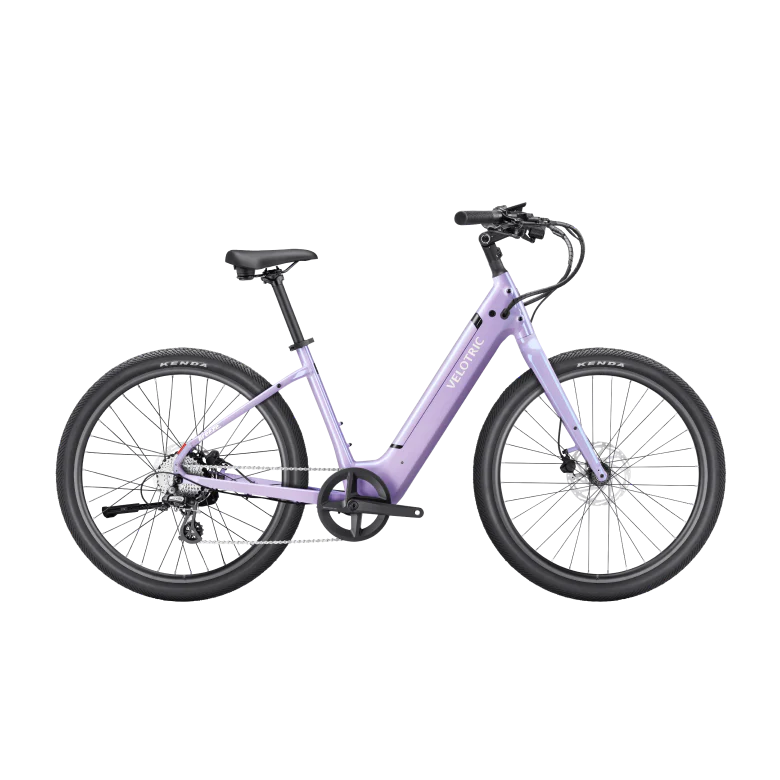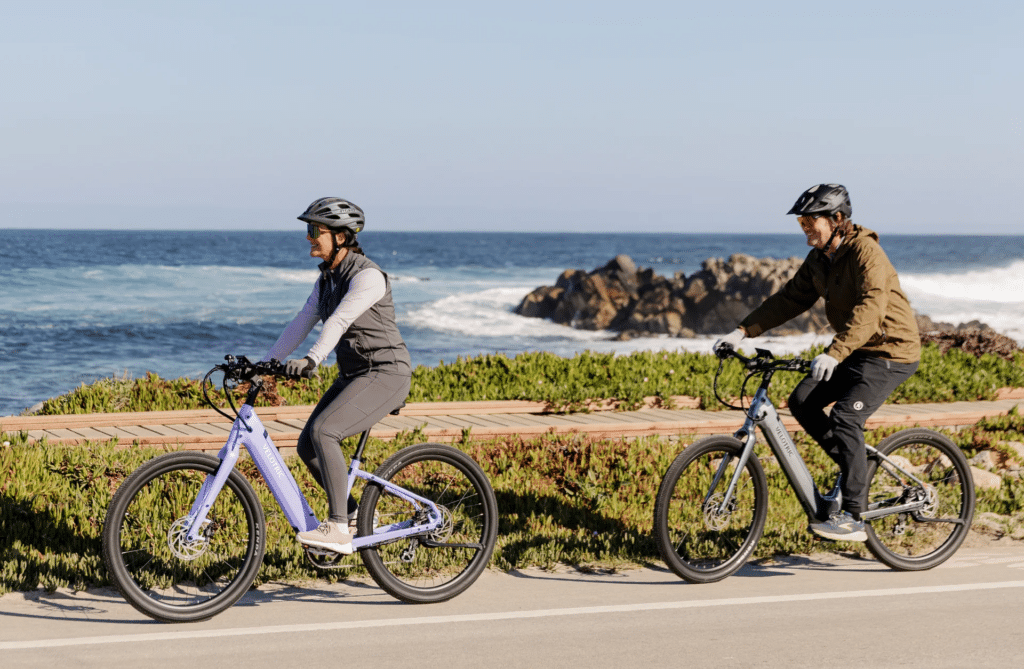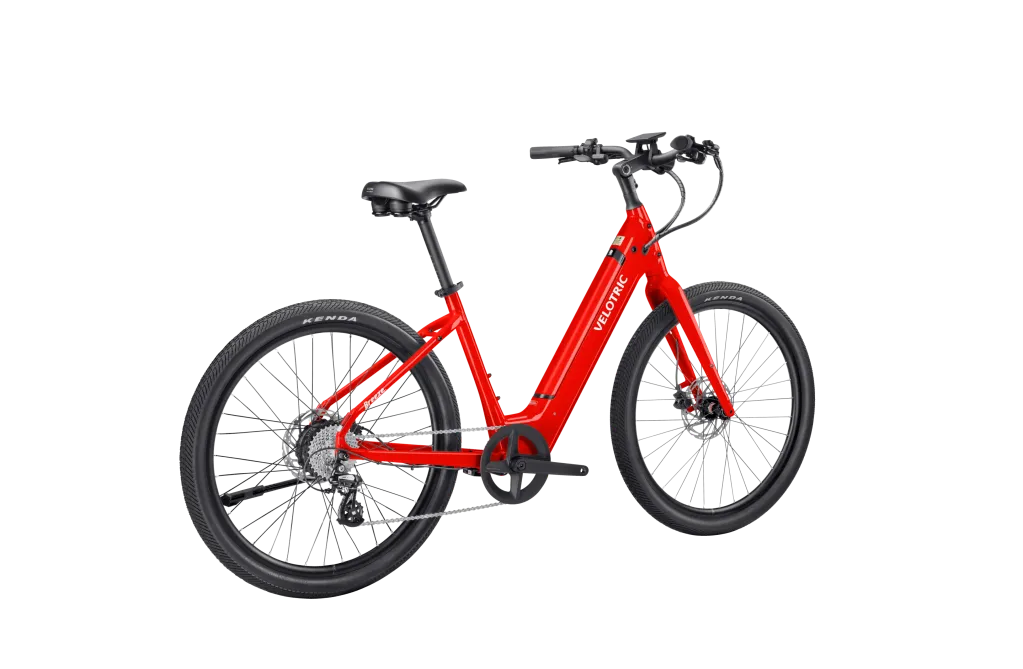Velotric’s latest model, the Breeze 1, is a part commuter, part cruiser electric bike designed to offer a relaxed ride without sacrificing performance. This new step-thru cruiser weighs in at just 48 lbs, making it significantly lighter than most e-bikes in its class. Despite the lightweight build, its 750W rear hub motor can reach Class 3 speeds (28 mph) when unlocked – so you can move fast when you need to. Velotric has built a reputation with earlier models like the Nomad 1 (fat-tire) and Discover 1 (commuter) for comfortable geometry and great value, and the Breeze 1 continues that trend with some modern upgrades in tech and design.
Currently priced at $1,799, the Breeze 1 slots in above Velotric’s budget offerings, but it justifies that with premium features like a torque sensor, a full-color display with app connectivity, and even Apple’s FindMy tracking built in.
In this review, written from online research and first impressions gathered from multiple sources, I’ll break down what the Velotric Breeze 1 brings to the table. We’ll dive into its performance, comfort, features, and where it fits in Velotric’s lineup. Does this lighter cruiser e-bike deliver the “best of both worlds” experience it promises? Let’s find out.
Click here for the latest price of the Velotric Breeze 1.
What I love about the Velotric Breeze 1
- Lightweight step-through frame: At ~48 lbs, it’s impressively light for a 750W cruiser, making it easy to handle and maneuver.
- Comfortable ride geometry: Pedal-forward design with a low 15″ standover and swept-back bars gives a relaxed, upright riding position.
- Powerful 750W motor (28 mph capable): Zippy acceleration and high top speed in unlocked mode offer thrilling performance.
- Dual pedal sensors (torque & cadence): SensorSwap™ tech lets you choose smooth torque sensing or easy cadence-based assist on the fly.
- Long-range battery & UL safety: 48V 13.4Ah (≈643 Wh) battery for up to ~75 miles in ideal conditions, and the battery + bike are UL-certified with high water-resistance (IPX7 battery, IPX6 bike).
- High-tech features: Full-color 3.5” display with tons of customization, Bluetooth app support, and Apple FindMy tracking for peace of mind.
- Quality components: Responsive hydraulic disc brakes, puncture-resistant 27.5×2.2″ tires, and a smoother Shimano 8-speed Altus drivetrain (a step up from the base-level parts on older models).
- Stylish design and options: Sleek, streamlined step-through frame available in 5 colors (e.g. Ocean Mist, Violet Haze, Scarlet, Satin White, Slate Gray) and two sizes (fits riders ~4’11” to 6’4”). It definitely looks more modern and less bulky than many cruisers.
What I hate about the Velotric Breeze 1
- No suspension at all: The Breeze 1 has a fully rigid frame and fork – great for weight savings and efficiency, but it can make bumpy roads a bit jarring compared to bikes with suspension.
- No included rack or fenders: Unlike some commuter bikes, it comes bare. You’ll have to purchase a rear rack or fenders separately if you need cargo capacity or all-weather utility.
- Apple FindMy is iPhone-only: The tracking feature is awesome if you have an Apple device, but essentially useless for Android users (a limitation on Velotric’s newer models).
- Throttle is inactive in 0 assist: As with other Velotric e-bikes, you can’t use the throttle from a dead stop unless you’re in pedal assist mode. It’s a minor gripe, but some riders prefer a throttle that works at zero assist for easier take-off.
- Top speed overshoot: In the display settings you can unlock 28 mph, but the bike doesn’t strictly cap itself there – testers have noted it can creep up around 30 mph, which might be a firmware quirk. Not a huge issue (more speed!), but worth noting for Class 3 law sticklers.
- Missing luxury touches: Given the price, a few upgrades would have been nice – e.g. including a suspension seatpost (Velotric’s Nomad 2 comes with one) or perhaps a slightly nicer derailleur. The Shimano Altus 8-speed works fine, but at $1.8k a Shimano Alivio or similar would have been welcome. These aren’t deal-breakers, just areas for potential improvement.

Velotric Breeze 1 in its step-thru glory. The frame is sleek and low-slung, making it easy to mount and stand over. Unlike the swoopy “beach cruiser” frames of old, Velotric went with a modern look that still achieves a laid-back riding posture. The Breeze 1 comes in two frame sizes and five color options, shown here in a Lavender shade.
How fast and powerful is the Velotric Breeze 1?
Don’t let the relaxed cruiser styling fool you – the Velotric Breeze 1 can move. It ships as a Class 2 e-bike (20 mph top speed out of the box), but owners can easily unlock Class 3 performance via the display settings for speeds up to 28 mph. Velotric wisely kept the same robust 750W rear hub motor used in their larger bikes, rather than downgrading it for this lightweight model. That means you get plenty of pep and torque when you hit the throttle or pedal in a high assist level. In fact, the Breeze 1 feels like a “lightweight alternative to the Discover 2 without sacrificing power” – it’s nimble and responsive, yet still capable of a thrilling burst of speed when you want it.
The motor is rated for 65 Nm of torque, which is slightly less grunt than Velotric’s burlier Nomad/Discover models (those are around 75 Nm). In practice, that translates to slightly tamer low-end acceleration – but the upside is a smoother power delivery that’s easier to control from a standstill. Thanks to the dual sensor setup, you can choose how that power comes on: the cadence sensor mode will engage the motor after about a quarter-turn of the pedals and give a more immediate “boost” (almost like a foot throttle), whereas the torque sensor mode responds proportionally to your pedal effort for a more natural feel. Early reviewers report that the cadence sensor is tuned well – it kicks in quickly without an awkward delay, but also doesn’t over-boost or lurch too hard. Meanwhile, the torque sensor mode is impressively smooth, making the Breeze ride “as smoothly as any hub motor/torque sensor combo” out there. It’s great to have the option to swap between the two styles on a single bike, catering to both casual riders and enthusiasts.
The Velotric Breeze 1 handles hills well but isn’t a pure hill-climber. As a rear hub motor bike geared for cruising, it performs impressively with pedal assist, especially using the torque sensor and a lower gear. However, on throttle alone, it slows to a steady crawl on steep grades. This is typical for a 750W hub bike—it can handle moderate hills, but for steeper ones, you’ll need to downshift and pedal. Fortunately, its lighter weight makes climbing easier. For city inclines and bridges, it’s more than sufficient, just not a torquey mid-drive or fat-tire climber.
Another aspect of speed control worth mentioning is that the Breeze 1 offers three riding modes (Eco, Trail, Boost), each with five levels of assist, effectively giving you 15 assist settings to fine-tune how the bike behaves. In Boost mode at max assist, the Breeze unleashes its full 750W potential for that 28+ mph capability. In Eco mode at low assist, it conserves energy and feels more like a mild push. The display and companion app even let you toggle between Class 1/2/3 settings easily, so if you need to adhere to local e-bike laws (say you travel to an area with a 20 mph limit), you can dial it down. There’s also a cruise control feature – if you hold the throttle steady for a few seconds, the bike can maintain that speed on its own, which is a neat addition for an effortless ride on long straight paths.
On the braking side of the performance equation, Velotric didn’t cut corners. The Breeze 1 is equipped with Tektro hydraulic disc brakes with 180 mm rotors front and rear. These brakes provide strong, confidence-inspiring stopping power, which is especially important when you’ve got a 28 mph capable bike. The brake levers even have motor cutoffs for safety. Also worth noting is the through-axle wheel setup Velotric chose for this bike. Unlike quick-release skewers, thru-axles add stiffness and security to the wheels. It’s a small detail, but it speaks to the bike’s higher-quality build and focus on stable, precise handling even at speed.
How far can Velotric Breeze 1 go on a charge?
The Velotric Breeze 1 is powered by a 48 V, 13.4 Ah lithium-ion battery, which is neatly integrated into the down tube of the frame. This works out to about 643 Wh of capacity (Velotric also quotes it as 627 Wh in some places – a minor discrepancy, but roughly in the same ballpark). In terms of range, Velotric claims up to 75 miles (120 km) on a single charge in ideal conditions. Keep in mind, that figure is likely achieved using the lowest assist in Eco mode with a light rider on flat terrain. Real-world range will vary widely based on how you ride.
If you’re zipping around in Boost mode and using the throttle frequently, you might realistically see on the order of 30-40 miles of range – still quite solid. On the other hand, if you stick to moderate assist levels and do lots of easy pedaling, getting 50-60+ miles on flatter routes seems achievable. The efficient 2.2″ tires and lighter weight of the Breeze help stretch the range; there’s less drag to overcome compared to fat-tire or heavier e-bikes. In one controlled test we found from a reviewer online, the Velotric Breeze 1 actually outperformed what its raw battery spec might suggest, thanks to those efficiency gains. So while the battery isn’t enormous, the bike makes good use of the energy.
One thing we appreciate is that Velotric’s battery and electronics are UL 2849 certified, meaning they meet stringent safety standards. That’s an extra layer of reassurance against any potential battery issues. The battery is also removable and lockable – you can take it out with a key for charging off the bike or for security. Velotric gave the pack an IPX7 water-resistance rating, so it’s highly waterproof – it can even be submerged in up to 3 feet of water without damage (though we don’t recommend trying that!). The rest of the bike is IPX6, so you can confidently ride in rain or hose it down after a ride without worry. In practical terms, you won’t need to baby this e-bike if the weather turns or if you hit the occasional puddle.
Charging the battery from empty takes around 5–6 hours with the included 4A charger. If you have a long daily commute, you could top it off at work midday (by removing the battery) to effectively double your range. And if range is a major concern, Velotric offers spare batteries for purchase – though given the decent efficiency of the Breeze, most riders will find the stock range ample for leisurely rides, beach cruises, and around-town errands.
Is the Velotric Breeze 1 comfortable without suspension?
With no suspension on the Velotric Breeze 1, comfort is a key concern—and the answer is yes, the ride is very comfortable on the terrain it’s intended for. Designed as a cruiser for pavement, boardwalks, and smooth paths, its comfort comes from ergonomics and design. The swept-back “Dutch-style” handlebar and adjustable-angle stem create an upright, relaxed posture. The 15″ step-through frame makes mounting easy, and two size options ensure a good fit. The result is a natural and easy-going ride—no hunching or stretching, just a relaxed, heads-up stance for enjoying the scenery or navigating traffic.

The Velotric Breeze 1 in action is every bit the casual cruiser. The swept-back bars and well-positioned saddle keep the rider upright with minimal strain on wrists or back. On smooth asphalt or packed trails, the bike glides along pleasantly. Velotric’s adjustable stem allows riders to fine-tune the handlebar height/angle for even more comfort.
To further enhance comfort, Velotric paid attention to the contact points. The saddle (Velotric’s Comfort Max) is wide and plush, and it’s spring-supported – underneath are dual springs that absorb small bumps and road vibrations. This is a smart inclusion given the rigid frame; those seat springs act as a mini suspension for your tush. The stock seat is actually one of the nicer ones in this category, and most riders will find it plenty cushy for medium-length rides. The grips are another highlight – they are ergonomic, with a blend of mushroom pattern and knurled texture for grip. They feel soft and tacky, reducing hand fatigue. There’s even a built-in bell on the handlebar for convenience. Little things like this show that Velotric didn’t bare-bones the Breeze 1 despite removing the fork suspension.
On rough roads, the lack of a suspension fork is noticeable—potholes and washboard bumps will jolt you more than a bike with front shocks. It’s a trade-off for lighter weight and efficiency. For its intended use—city streets, bike lanes, park paths, and occasional hard-pack trails—the 2.2″ balloon tires and cushy saddle/grips help smooth out normal bumps. Kenda tires run at lower pressure, absorbing minor cracks and gravel. If you expect frequent bumps, consider upgrading to a suspension seatpost. Velotric’s Nomad 2 includes one, and many riders wish the Breeze 1 did too. Adding an aftermarket suspension seatpost is an easy swap and can significantly improve comfort, especially for long rides or those with back issues.
Overall, within its design intent, the Velotric Breeze 1 nails comfort. You truly get that “breeze” feeling – the bike encourages you to sit back, relax, and just enjoy the ride. It’s the kind of e-bike you can take for a leisurely beach boardwalk cruise or a neighborhood stroll and feel no strain at all. Just keep in mind it’s not a mountain bike; if your ride will involve a lot of bumps, you’ll need to slow down or consider those minor upgrades to maintain the cloud-like ride quality.
What features and tech does the Velotric Breeze 1 include?
One area where the Velotric Breeze 1 really shines is in its features and modern tech integration. Velotric equipped this bike with many of the bells and whistles that we’ve come to love throughout the Velotric series, and even a few new tricks.
The display and control system on the Breeze features a 3.5-inch color LCD display that’s bright and easy to read, showing speed, battery level, assist level, odometer, and more. Velotric’s display is known for its user-friendly interface with lots of adjustability, allowing you to tweak power profiles (Eco/Trail/Boost), switch between torque and cadence sensor modes, and view advanced data like motor output and temperature. The left-hand control pad has 7 buttons, including turn signals, lights, a horn, and standard assist/power controls. A USB-C charging port lets you power a phone or GPS from the e-bike’s battery—handy for navigation or long rides.
The Velotric Breeze 1 offers Bluetooth connectivity and a mobile app for iOS/Android. Pairing is simple—hold the “M” button, scan the QR code, and you’re linked. The app mirrors display functions, lets you customize settings, and includes trip tracking, ride records, and firmware updates. Apple users get a special perk: integration with Apple’s Find My network, allowing the bike to function like an AirTag for theft recovery. However, there’s no Android equivalent— a common complaint about Velotric’s Find My-equipped models.
The lighting system is another highlight. A 400-lumen front headlight stays on during the day and brightens for night rides. In the rear, unique twin tail lights on the seatstays serve as running and brake lights while also functioning as turn signals, activated via handlebar buttons. Wide spacing makes them highly visible. This full automotive-style lighting setup is rare in this class and adds safety for commuting or riding in traffic. All lights run off the main battery, eliminating the need for separate power sources.
In terms of the drivetrain and hardware, the Velotric Breeze 1 uses an 8-speed Shimano setup. The rear derailleur is a Shimano Altus, which is a mid-level component a notch above the base Tourney. Shifting is done with a thumb shifter on the right handlebar (Shimano rapid-fire style) that clicks crisply through gears. The gear range (11-32T cassette with a 46T chainring) is sufficient to pedal comfortably up to ~28 mph without spinning out. For context, Velotric’s older Discover 1 used a low-end Tourney derailleur, so the move to Altus on the Breeze is a welcome upgrade – it should offer more precise shifting and longevity. The cadence of pedaling required is well-matched to the assist; riders found they could contribute meaningfully at higher speeds without their legs flailing, thanks to that 8-speed range.
Other features include a half-twist throttle on the right side (integrated next to the grip) for when you don’t feel like pedaling at all. The throttle is live from 0 mph in any assist mode except assist level 0 (as noted in the dislikes) – it’s a safety/legality design choice, though some find it inconvenient. The Breeze also has motor inhibitors on the brake levers (cuts power when braking) and an integrated bell for friendly alerts. The bike even has cruise control capability, as mentioned earlier, which kicks in after maintaining throttle for a few seconds – a rare feature that long-distance riders will appreciate on straight stretches.
Velotric ships the Breeze 1 with a sturdy kickstand and all the necessary reflectors, but as noted, accessories like racks or fenders are optional extras. The frame does have mounting points for a rear rack (and Velotric sells a compatible one that can carry up to 66 lbs), as well as mounts for fenders. There are also bottle cage bosses on the down tube. So you can outfit the Breeze for commuting or errands, it just isn’t factory-equipped with those add-ons by default. In a way, Velotric left the customization to the user: you get the core high-value features built-in (electronics, sensors, lights, etc.) but the physical accessories you can choose as needed. For many casual riders, the stripped-down setup is fine and keeps the bike lighter and cleaner-looking.
Overall, the Velotric Breeze 1 comes through as a fully featured modern e-bike: it’s not missing any of the high-tech goodies one might want, and in fact it surpasses a lot of competitors in this price range by offering things like turn signals, dual sensor control, app support, and tracking. These features make the bike feel “smart” and up-to-date. Velotric has essentially taken the best features from their lineup (like those seen on the higher-end Velotric Thunder 1 and Discover 2) and packed them into the Velotric Breeze 1, which stands out from typical cruiser e-bikes that often have more basic electronics.
Velotric Breeze 1 vs. Nomad 1 vs. Discover 1: Where does it fit in Velotric’s lineup?
Velotric now has a diverse lineup of e-bikes, so you might be wondering how the Breeze 1 compares to the brand’s other popular models – particularly the Nomad 1 and Discover 1, which were Velotric’s earlier hits in the fat-tire and commuter categories. The Velotric Breeze 1 essentially carves out a niche as Velotric’s “cruiser hybrid” offering, blending traits of the Discover (city commuter) with a more laid-back cruiser style, and integrating some of the latest tech Velotric has developed.
Compared to the Discover 1: The older Velotric Discover 1 was a very budget-friendly step-through commuter (often on sale around $1,199) that came with a suspension fork, 26×2.5″ balloon tires, and a cadence sensor-based 500W (peak 750W) system. It was praised for its smooth ride and stylish looks, but it was also a fairly heavy bike (around 62 lbs) and had entry-level components to hit that low price. The Velotric Breeze 1 can be seen as an upmarket evolution of the Discover concept. It forgoes the suspension fork, but it adds the torque sensor, a more advanced display/app, better brakes (the first batches of Discover 1 even had mechanical discs, whereas Breeze is hydraulic), and more refined frame engineering (the Breeze’s frame is a lighter triple-butted aluminum versus the more utilitarian frame of the Discover). In terms of ride, the Discover 1’s front suspension and slightly wider tires gave it an edge on rough roads, but the Breeze 1’s lighter weight and torque sensor give it a more responsive, higher-performance feel.
If Discover 1 was about comfort on a budget, the Breeze 1 is about comfort with a side of speed and sophistication. At $1799, the Breeze is pricier, but you’re paying for the upgraded motor power (28 mph vs 20 mph), dual-sensor pedal assist, and tech features that the old Discover simply didn’t have. One notable difference: Discover 1 (and the newer Discover 2) come fully equipped with fenders and rear rack, whereas Breeze doesn’t include them. So if your priority is a turn-key commuter with maximum utility and you don’t care about weight, the Discover series might still appeal. But for a rider who values the lighter weight and doesn’t mind adding accessories as needed, the Breeze 1 offers a more premium ride experience. In many ways, the Breeze 1 effectively replaces the Discover 1 in Velotric’s lineup as the everyday city/cruiser bike, but aimed at a slightly higher-end market segment.
Compared to the Nomad 1: The Velotric Nomad 1 is a very different beast – it’s a fat-tire (26×4″) e-bike built for off-road adventures, beach cruising, and all-terrain capability. It has a front suspension fork with 80mm travel, massive tires, and was geared toward riders who wanted to tackle sand, snow, or trails. Naturally, the Nomad 1 is much heavier (around 72 lbs) and bulkier. It also used only a cadence sensor for assist and topped out at Class 2 (20 mph) in stock form, though it had similar 750W power on tap. The Breeze 1, in contrast, is not meant for off-roading – its tires are narrower and smoother, and it lacks suspension. Where the Nomad 1 can steamroll over terrain and provide a very cushioned ride (thanks to its fat tires and fork), the Breeze 1 feels more agile and efficient on pavement. It accelerates quicker and is easier to pedal at higher speeds because you’re not dragging big knobbies on asphalt.
If you tried to ride the Nomad 1 and Breeze 1 side by side on a city ride, the Breeze would likely be faster and require less effort, especially without assist. However, take them onto a dirt trail or loose sand, and the Nomad would leave the Breeze behind, as that’s its domain. The Nomad 1 was also a bit more affordable (around $1,399) due to simpler tech, making it a great value for a fat-tire ebike. The Breeze 1’s 65 Nm torque sensor system can’t match the sheer traction of a fat-tire on a steep hill, but it’s far more refined for urban use.
In Velotric’s lineup today, the Breeze 1 fills the gap for a rider who wants a blend of both worlds: It’s more commuter/city-oriented than a Nomad, but more relaxed and cruiser-like than a sporty road e-bike. It’s also leveraging Velotric’s latest innovations. For instance, Velotric introduced the dual sensor system first on the Nomad 2 and new Discover 2 – the Breeze 1 benefits from that same “2 sensors are better than 1” approach, whereas the original Nomad 1/Discover 1 only had cadence sensors. So in a way, the Breeze 1 is part of Velotric’s second-generation of bikes that focus on enhanced ride feel and tech.
To sum up the comparison: if you’re an off-road explorer or need maximum comfort on very rough terrain, the Nomad (or its successor Nomad 2) would be the pick due to the fat tires and suspension. If you’re a practical commuter on a tight budget, an older Discover 1 (if you find one) or the new Discover 2 with its included rack/fenders might make sense. But if you want a bike that’s lightweight, fun, and versatile for city cruising with modern features, the Breeze 1 is likely Velotric’s best offering. It sits right in the middle ground – capable of zipping around town for errands or work commutes, weekend joyrides, and even tackling the occasional park trail, all while being easy to live with (easy to lift, easy to ride, easy to adjust). Velotric basically now offers two style options in the “full-size 750W” category: the Discover 2 which is more comfort commuter with all accessories and a bit more heft, and the Breeze 1 which is the slimmed-down cruiser with a techy twist. For many riders, the Breeze 1 will hit the sweet spot by saving weight and cost (it’s about $100 cheaper and 10+ lbs lighter than the fully-loaded Discover 2) while still delivering the core performance.
The Freshly Charged Take
From all the early reports and our analysis, the Velotric Breeze 1 emerges as a well-rounded and exciting entrant in the e-bike market. It’s a bike that manages to be both easy-going and high-performing. On one hand, you have the chilled-out cruiser DNA: upright posture, comfortable saddle, intuitive handling – a ride that invites anyone, including e-bike beginners, to hop on and feel at ease. On the other hand, the Breeze 1 brings serious capability with its 28 mph speed, punchy acceleration, and a suite of tech features typically found on more expensive models. In many ways, it doesn’t feel like a compromise. You’re not stuck with a sluggish “beach cruiser” that can’t climb or a high-speed racer that’s uncomfortable – the Breeze 1 blends elements of both, which is likely what Velotric intended by calling it part commuter, part cruiser.
Of course, no e-bike is perfect. The lack of suspension means the Velotric Breeze 1 isn’t the bike for bombarding through potholes or rocky trails at full tilt. Riders who need the plushest ride might need to invest in a suspension seatpost or look at Velotric’s other models. And while the bike’s lightweight approach is refreshing, some utilitarian riders might lament having to add their own rack or fenders. Additionally, the cutting-edge Apple tracking feature is fantastic – but only if you’re in Apple’s ecosystem. These are relatively minor downsides in the bigger picture, but they’re worth considering based on your needs.
All things considered, the Velotric Breeze 1 stands out as an engaging, thoughtfully designed e-bike. It fills a niche for those who want a capable daily rider that’s not bulky or complicated. It’s the kind of e-bike you’ll look forward to riding, whether you’re cruising along the waterfront for fun or zipping through city blocks on your commute. Velotric has kept the price competitive for what you get – there’s a lot of value in the form of quality components (hydraulic brakes, Shimano drivetrain), safety (UL certification, great lights), and ride-enhancing tech (dual sensors, customizable assist). After going through its features and performance, it’s clear that the Breeze 1 isn’t just a slight breeze – it’s more like a gust of fresh air in the cruiser e-bike category. If you’re seeking a new e-bike that offers comfort, speed, and modern features all-in-one, the Breeze 1 is definitely worth considering as one of the top choices in Velotric’s lineup for 2025.
E-Bike Comparison Tool
Use our Freshly Charged E-bike Comparison Tool to evaluate this E-bike alongside more than 450 other E-bikes. Compare and organize bikes by factors such as price, pedal-assisted speed, battery size, weight, tire size, and more!







